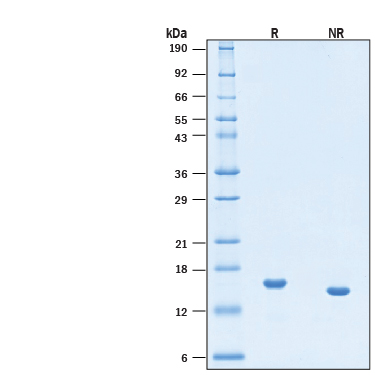Recombinant Human IL-21 Protein, Animal-Free Best Seller
R&D Systems, part of Bio-Techne | Catalog # BT-021-AFL

Key Product Details
Product Specifications
Source
Gln32-Ser162 with a N-terminal Met
Produced using non-animal reagents in an animal-free laboratory.
Purity
Endotoxin Level
N-terminal Sequence Analysis
Predicted Molecular Mass
SDS-PAGE
Activity
The ED50 for this effect is 5.00-50.0 ng/mL.
Scientific Data Images for Recombinant Human IL-21 Protein, Animal-Free
Animal-Free™ Recombinant Human IL‑21 Protein Bioactivity.
Recombinant Human IL-21 (Catalog # BT-021-AFL) as measured in a cell proliferation assay using B9 mouse hybridoma cells. The ED50 for this effect is 5.00-50.0 ng/mL.Animal-Free™ Recombinant Human IL‑21 Protein SDS-PAGE.
2 μg/lane of Animal-Free™ Recombinant Human IL‑21 Protein (Catalog # BT-021-AFL) was resolved with SDS-PAGE under reducing (R) and non-reducing (NR) conditions and visualized by Coomassie® Blue staining, showing bands at 16 kDa, under reducing conditions.Formulation, Preparation and Storage
Lyophilized: BT-021-AFL
| Formulation | Lyophilized from a 0.2 μm filtered solution in PBS with Trehalose. |
| Reconstitution | Reconstitute 25 μg size at 250 μg/mL in PBS and all the other sizes at 500 μg/mL in PBS. |
| Shipping | The product is shipped at ambient temperature. Upon receipt, store it immediately at the temperature recommended below. |
| Stability & Storage | Use a manual defrost freezer and avoid repeated freeze-thaw cycles.
|
Liquid: BT-021-AFL/LQ
| Formulation | Supplied as a 0.2 μm filtered solution in PBS. |
| Shipping | The product is shipped with dry ice or equivalent. Upon receipt, store it immediately at the temperature recommended below. |
| Stability & Storage | Use a manual defrost freezer and avoid repeated freeze-thaw cycles.
|
Background: IL-21
Interleukin-21 (IL-21) is an approximately 14 kDa four-helix-bundle member of the family of cytokines that utilize the common gamma chain ( gammac) as a receptor subunit. gammac is also a subunit of the receptors for IL-2, IL-4, IL-7, IL-9, and IL-15 (1). IL-21 is produced by activated T follicular helper cells (Tfh), Th17 cells, and NKT cells (2-6). It exerts its biological effects through a heterodimeric receptor complex of gammac and the IL-21-specific IL-21 R (2, 7). Tfh-derived IL-21 plays an important role in the development of humoral immunity through its autocrine effects on the Tfh cell and paracrine effects on immunoglobulin affinity maturation, plasma cell differentiation, and B cell memory responses (4, 8, 9). It is also required for the migration of dendritic cells to draining lymph nodes (10). IL-21 regulates several aspects of T cell function. It co-stimulates the activation, proliferation, and survival of CD8+ T cells and NKT cells and promotes Th17 cell polarization (3, 5, 6, 11, 12). It blocks the generation of regulatory T cells and their suppressive effects on CD4+ T cells (13, 14). IL-21 R engagement enhances the cytolytic activity and IFN-gamma production of activated NK cells but limits the expansion of resting NK cells (15). In addition, IL-21 suppresses cutaneous hypersensitivity reactions by limiting allergen-specific IgE production and mast cell degranulation (16). Dysregulation of the IL-21/IL-21 R system contributes to the development of multiple immunological disorders (1, 17). The 133 amino acid (aa) mature human IL-21 shares 63% and 61% aa sequence identity with mouse and rat IL-21, respectively. Alternative splicing generates an additional isoform with a substitution of the C-terminal 16 amino acids (18).
References
- Tangye, S.G. (2015) Curr. Opin. Immunol. 34:107.
- Parrish-Novak, et al. (2000) Nature 408:57.
- Coquet, J.M. et al. (2007) J. Immunol. 178:2827.
- Vogelzang, A. et al. (2008) Immunity 29:127.
- Korn, T. et al. (2007) Nature 448:484.
- Nurieva, R. et al. (2007) Nature 448:480.
- Asao, H. et al. (2001) J. Immunol. 167:1.
- Zotos, D. et al. (2010) J. Exp. Med. 207:365.
- Rankin, A.L. et al. (2011) J. Immunol. 186:667.
- Jin, H. et al. (2009) J. Clin. Invest. 119:47.
- Frohlich, A. et al. (2009) Science 324:1576.
- Yi, J.S., et al. (2009) Science 324:1572.
- Peluso, I. et al. (2007) J. Immunol. 178:732.
- Bucher, C. et al. (2009) Blood 114:5375.
- Kasaian, M.T. et al. (2002) Immunity 16:559.
- Tamagawa-Mineoka, R. et al. (2011) J. Invest. Dermatol. 131:1513.
- Ma, J. et al. (2011) Cytokine 56:133.
- Rahman, M. et al. (2007) FEBS Lett. 581:4001.
Long Name
Alternate Names
Gene Symbol
UniProt
Additional IL-21 Products
Product Documents for Recombinant Human IL-21 Protein, Animal-Free
Manufacturing Specifications
Animal-Free Manufacturing ConditionsOur dedicated controlled-access animal-free laboratories ensure that at no point in production are the products exposed to potential contamination by animal components or byproducts. Every stage of manufacturing is conducted in compliance with R&D Systems' stringent Standard Operating Procedures (SOPs). Production and purification procedures use equipment and media that are confirmed animal-free.
Production
- All molecular biology procedures use animal-free media and dedicated labware.
- Dedicated fermentors are utilized in committed animal-free areas.
- Protein purification columns are animal-free.
- Bulk proteins are filtered using animal-free filters.
- Purified proteins are stored in animal-free containers in a dedicated cold storage room.
Quality Assurance
- Low Endotoxin Level.
- No impairment of biological activity.
- High quality product obtained under stringent conditions.
- For ex vivo research or bioproduction, additional documentation can be provided.
Product Specific Notices for Recombinant Human IL-21 Protein, Animal-Free
For preclinical, or clinical ex vivo use

